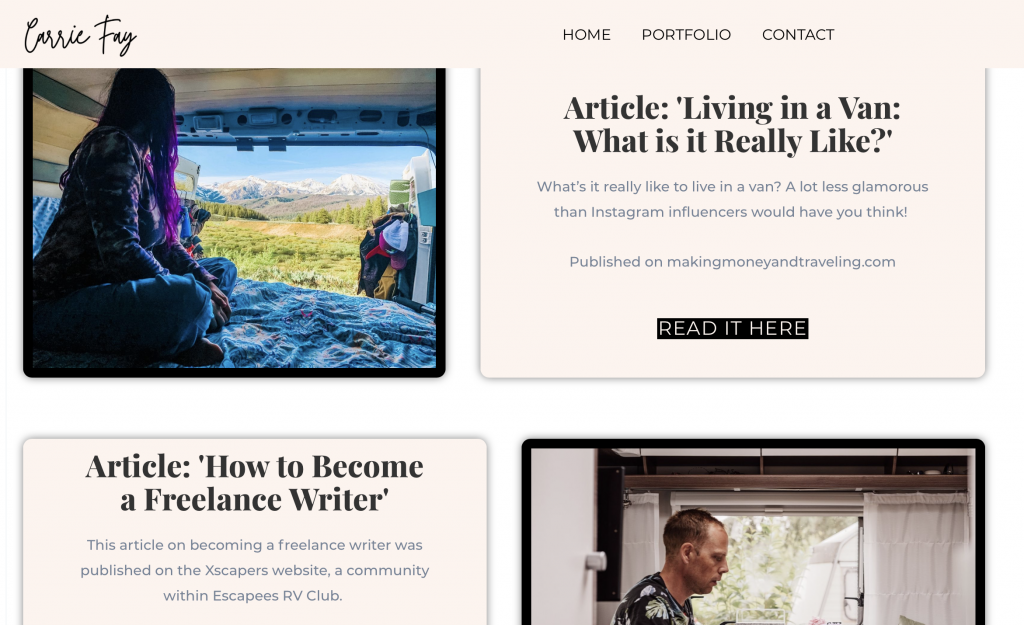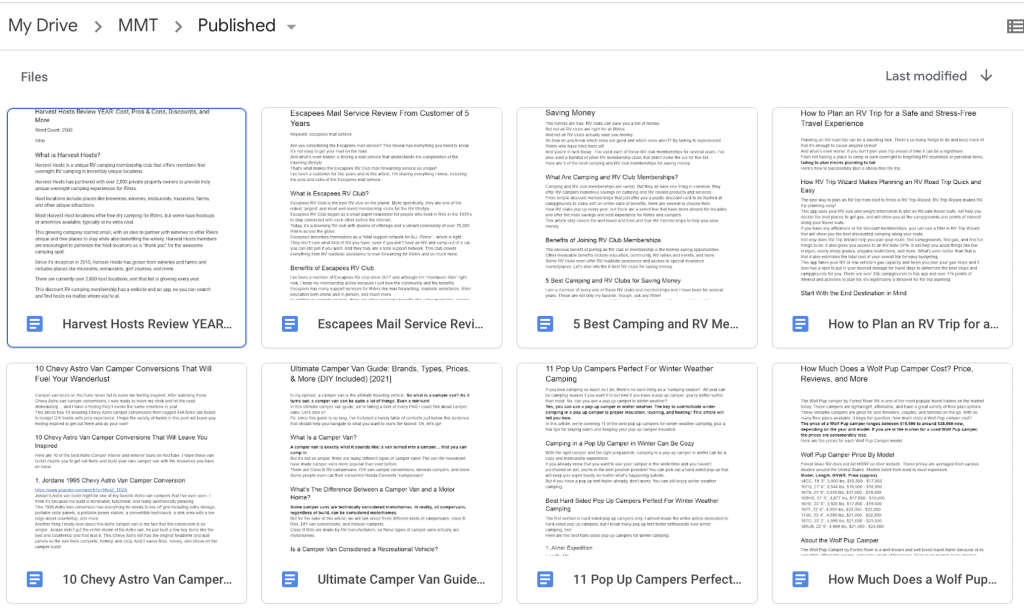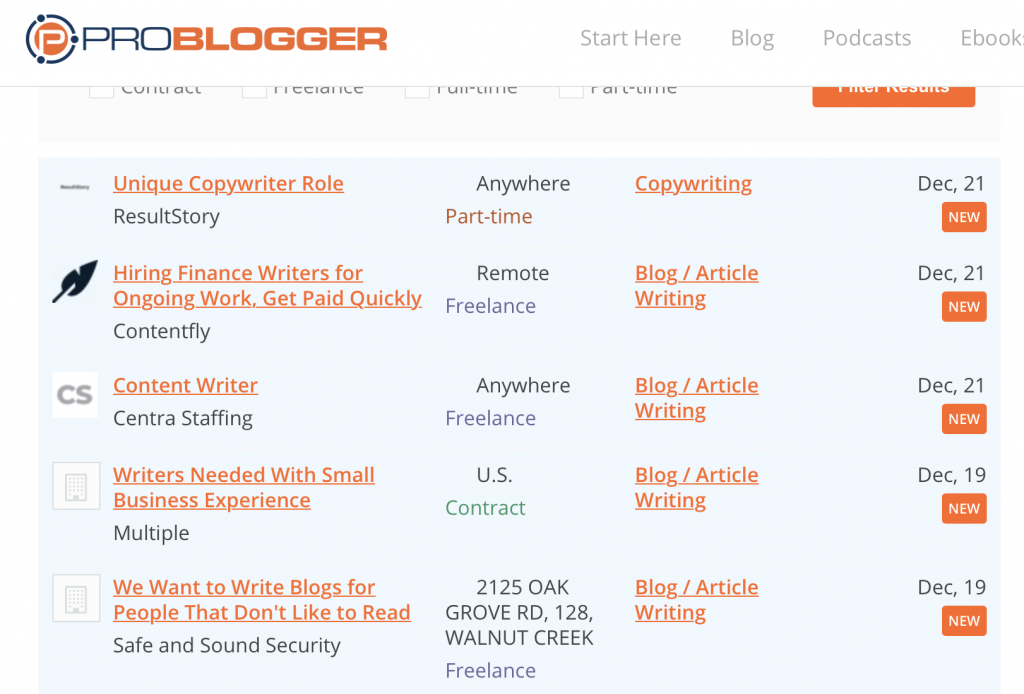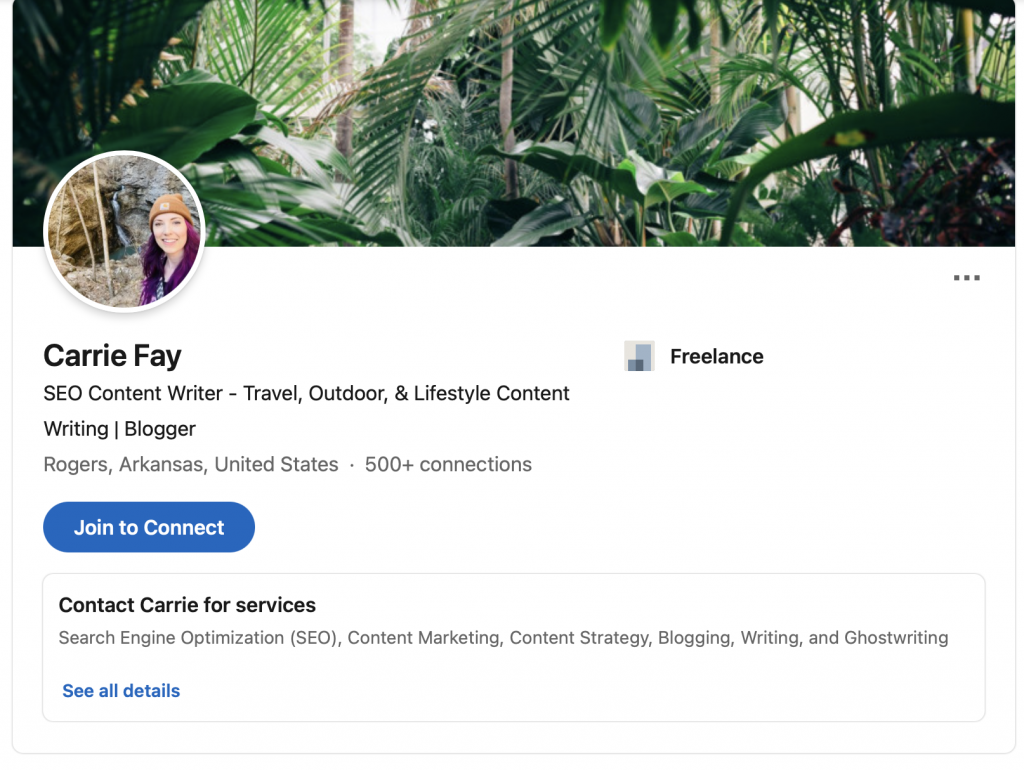Do you want to know how to become a freelance writer with no experience?
If so, you’re in luck, because I did it and I’m going to tell you everything I know here.
These days, I’m a fully-booked freelance writer. I earn more with my freelance writing than I ever earned at any job I’ve ever had. And I work less than half the time that I used to.
Want to know how to do what I did? It’s pretty simple, but it will require work. Let’s get into it.
How to Start Freelance Writing With No Experience
In my opinion, freelance writing is one of the easiest service-based side hustles you can start if you don’t have experience.
It’s not hard in a technical way, but it’s hard in the way that it requires work and dedication on your part. Here are the steps for how to become a freelance writer with no experience.
1. Choose a Niche
Before you do anything else, you need to choose a niche. Your niche will determine what you write and what kind of clients you want to work with.
What is A Niche?
A niche is basically a focused segment of a particular market with specific interests and types of content. For example, parenting is a broad niche. Travel is a broad niche. Tech is a broad niche.
A more specific niche example would be ‘single moms of toddlers’ (parenting). Or, ‘millennial RV travel in the USA’ (travel).
There is freelance writing work in just about every niche you can imagine, so don’t worry about being too specific here. It’s best to start with a broad niche or two and narrow it down as you gain experience.
How to Choose a Freelance Writing Niche
The best place to start when choosing a freelance writing niche is to simply start with what you know.
It’s much easier to write content about what you already know than it is to take a freelance writing gig in a niche you have no experience with.
Start with a passion, a hobby, previous work experience, or just a general interest.
You can start with a few niches that feel interesting to you and narrow it down as you create content and gain experience.
Personally, my niche has changed a few times over the years. And I’m sure it will change again as I gain more experience and my interests and hobbies change.

Download this FREE ebook learn 60+ ways to earn an income from anywhere!
2. Create a Portfolio

Your portfolio is a crucial part of becoming a freelance writer with no experience. This is how you’ll get clients with no experience!
What is a Freelance Writing Portfolio?
A freelance writing portfolio is a collection of written content that you create to use as “work examples” to show potential clients.
You don’t have to have previous freelance writing client experience to become a successful freelance writer, because you can create it yourself.
A freelance writing portfolio can be stored on Google Drive, LinkedIn, a portfolio website, or your own website.
In my opinion and my experience, the absolute best way to create a portfolio is to build your own freelance writing website. But this isn’t necessary when you’re first getting started.
How to Create a Freelance Writing Portfolio
There are many ways to create a freelance writing portfolio. First (and one of the easiest ways) is to upload your sample pieces into a Google Drive folder.
With a Google Drive folder of sample work, you can email it or send the link to potential clients.
The downsides to this method include the fact that your work isn’t readily available online and can only be seen by people that you share the link with. This method is easy, but it’s not the best or most professional-looking option.
Next, and this is the method that I started with, is to create a free Contently profile and portfolio.
Contently is a website to help freelancers find clients, but I only ever used them for their free portfolio.
You upload a profile picture and write a short bio and upload your sample pieces. Your portfolio is then on display to be discovered by potential clients, and you can also send the link to people.
You can see my Contently portfolio here.
Another method that’s similar to Contently is to use LinkedIn as a freelance writing portfolio. LinkedIn allows users to write blog posts and have them displayed on their public profile.
Additionally, you can write and publish sample pieces on a platform like Medium to use as a portfolio.
Your Own Portfolio Website

The best method to create a freelance writing portfolio is to create your own website. You can upload your portfolio pieces, have an “About Me” page, a contact form, AND a blog.
Learn how to create your own blog portfolio website here.
The benefits to having your own freelance writer website are endless, in my opinion. You can also write blog posts and make money from your website in addition to using it to attract clients.
This website (Making Money and Traveling) serves as a larger portfolio piece for me to show to potential clients, and I also have a professional freelance writer website here.
I have personally gotten clients from my freelance writer website and this blog, but with no work of my own! The clients found my websites and emailed me and it went from there.
Not only does having a website make you look more professional, it’s a client magnet. Finally, you can make money off of it, so it’s a win-win-win!
3. Create Sample Pieces

Sample pieces are the most important part of your portfolio. Your portfolio is the container, whether it’s a Google Drive folder, a website, or a Contently profile.
What Are Sample Pieces?
Sample pieces are articles! This is how you get freelance writing clients when you have no experience.
You don’t have to have previous work experience or previous clients to land new ones. You can literally create your “experience” yourself.
Articles speak for themselves. Your writing will speak for itself. When you pitch potential clients with no experience, the only way they will consider you is if you can provide them with examples of what you can do.
And it’s a bonus if you write articles for your own website or blog that begin to rank in Google or get shared a lot on social media.
How to Create Freelance Writing Sample Pieces

About the image: I write my articles in Google Docs and keep a folder of published articles. This is one method you can use to create your sample pieces before you build your website.
Once you choose a niche, you should have a general idea of what kind of content you want to create.
My first freelance writing niche was about RVs, RVing, and RV travel in the United States. So the types of articles I would write as sample pieces would be topics like:
- 10 Best RV Campgrounds in the Florida Keys
- How to Choose the Best RV Road Trip Route for Your RV Size
- How to Sanitize Your RV Fresh Water Tank
- 20 Best RV Accessories for Your First RV Road Trip
Come up with a few article ideas in your niche (or niches) that sound fun and exciting, and write them!
If you create your own website, use your sample pieces as your blog posts. That way you can use them as portfolio pieces, but they also go to work for you in the background by attracting readers to your website, which can also make you money.
Guest Posting
In addition to writing sample pieces just for your portfolio, start looking for blogs that accept guest posts.
Guest posting means writing a post for another blogger or website that’s published for their audience. You don’t get paid for it, but you do get exposure. Which, contrary to popular belief, can be helpful as a writer.
Guest posting can help drive traffic to your website and position you as an authority in your niche, and it can be used as an example of your writing for your portfolio.
I wrote this article with 100 blogs that accept guest posts for my client NichePursuits.
Here’s an example of a guest post I wrote a few years ago. As you can see, my writing style has changed dramatically with experience! I cringe at this article now, but it was one of the first free guest posts I’ve ever written.
4. Start Pitching
Once you have your niche, portfolio, and sample pieces, it’s time to start looking for freelance writing clients. You do this by pitching.
What Does Pitching Mean?
Pitching essentially means sending a “pitch” or a “proposal” for potential clients.
This is done by responding to job postings, sending emails, and sending proposals on freelance writing gig websites.
Cold pitching is the art of sending emails to businesses and potential clients that don’t have a job listing posted. Cold pitching is a great way to land high-paying clients, but it takes practice and time!
How to Find Potential Freelance Writing Clients to Pitch

Finding potential clients might feel overwhelming at first, but it’s much easier than it seems.
The first and easiest way is to look for freelance writing jobs on online job boards and gig websites.
The next way is to make a list of clients you’d love to work with and send them emails or messages on LinkedIn inquiring about writing articles for them.
The best (and easiest) place for beginners to find freelance writing jobs are job boards like ProBlogger, FlexJobs, and other freelance writing websites.
5. Get Visible Online

If you want to attract clients to you instead of going out searching for them, you need to get visible online. This means creating professional profiles on social media, a public portfolio, and more.
Freelance Writer Website
The first way to get visible online is to set up your freelance writer website. You can choose to have a simple, one-page website, or create a blog that acts as your writer website and portfolio.
A website will help you be more easily discovered and automatically makes you look more professional – meaning you can charge more money.
Using Social Media to Your Advantage
I’ve landed many freelance writing clients on social media. In fact, most of my clients have come from Facebook!
Early on in my entrepreneur journey I learned to become involved with Facebook groups and have made tons of connections that led to paying work.
Set up a professional LinkedIn profile and upload sample pieces. Connect with people in your niche or industry that you’d like to work with or are just involved in your industry somehow.
If you use Facebook for memes and post crazy and/or offensive stuff, it’s time to stop if you want to use it as a client-getting machine.
Clean up your Facebook profile (or lock it down totally private, or make a new one) and upload a professional photo. Join Facebook groups relevant to businesses in your niche.
For example, if you want to write in the parenting niche, join groups for parenting bloggers.
If you want to write in the travel niche, join groups for travel bloggers.
It’s not just businesses and companies that hire freelance writers! Small businesses, entrepreneurs, and bloggers have been my favorite clients to work for. And there are posts for freelance writers in those groups all the time!
6. Learn How to Network
Once you set up your social profiles and join the appropriate groups, you need to know how to properly network to land clients.
If you only post about needing freelance writing work or offering your services, people will see you as spammy. At best, people will just ignore you. At worst, you’ll be banned from the groups for spam.
What Does Networking Even Mean?
Networking is simply interacting with people in a strategic way to build business connections.
Social media or social networking platforms are a great place to find new freelance writing clients, but you have to do it in a certain way in order to be successful.
How to Network Strategically for Freelance Writing Clients
When you join Facebook groups with the intention of landing clients, first be sure that you’re familiar with the group rules.
The key to positioning yourself as the “go-to” freelance writer is all about how you connect and interact with people.
When you first join a group, your key objective should be to be as helpful as possible and not ask for anything in return.
In the beginning, start by scrolling the group and looking for comment threads you can participate in. Answer people’s questions, provide help and valuable resources, and do it for free.
This will automatically make people like you, and the more you interact, the more knowledgeable you seem to people. Also, if people get used to seeing your name in the group, you’ll be the first that comes to mind when they have questions.
After you start making friends in the group and helping people out, you can start responding to job posts and (if the rules allow it) posting offering your freelance writing services.
Only do this step once you’ve established yourself as a helpful group member and if the group rules allow it.
The key to landing clients using social media is to just be a nice, helpful, and genuine person. Provide value instead of asking for work, and clients will start to flock to you.
Today I am a fully-booked freelance writer, and I still get messages weekly from potential clients on Facebook asking if I have room in my schedule for them.
Where to Find Freelance Writing Jobs for Beginners With No Experience

So you know that you need sample pieces and professional social media profiles, but where do you look when you need to find freelance writing jobs?
Freelance Writing Websites
The first place to look when trying to find freelance writing jobs with no experience is freelance writing websites and job boards. Here are a few of my favorites.
- ProBlogger Job Board
- The Morning Coffee Newsletter
- FlexJobs
- Freelance Writing Job Board
- Freelance Writing Jobs (aka Gigs)
If you do research on this subject, you’ll find a lot of bloggers recommending many different types of websites.
Pro tips from my personal experience as a successful freelance writer:
You’ll see Upwork and Fiverr mentioned but take it from me: don’t waste your time on those platforms.
Clients on UpWork only want to pay pennies, and Fiverr can be very competitive.
Additionally, I don’t recommend signing up for content mills either.
Content mills include websites like Textbroker, iWriter, etc. These are essentially content agencies that work as a middleman between clients and writers.
Content mills pay very poorly and hurt the freelance writing industry as a whole. It’s very difficult to become a successful and profitable freelance writer when you get stuck writing for content mills.
Social Media
Next, social media is a great place to find freelance writing jobs. Facebook groups are a great place for finding freelance writing work, and so is LinkedIn.
LinkedIn even has their own job board with plenty of writing websites posted daily.
Use social media to your advantage, especially when you’re just starting out.
Cold Pitching
Finally, cold pitching is one of the best ways to land high-paying freelance writing clients. But this is an advanced strategy and one that you shouldn’t worry about too much when you’re just getting started out.
How to Get Better at Freelance Writing
Once you start freelance writing, how do you get better at it? Here are my top tips for becoming a better writer.
Start Your Own Blog
Starting my own blog has been vital in my growth as not only a freelance writer, but a writer in general.
My writing skill has improved dramatically, all because I created my own website.
Starting my own blog taught me about marketing, SEO, and different writing styles. If I hadn’t started my own blog, I don’t think I’d be as successful as I am today.
Take a Freelance Writing Course
Take a course! It doesn’t even have to be a freelance writing-specific course.
Examples of course topics that will help you as a freelance writer include:
- Freelance writing courses
- Marketing courses
- Copywriting courses
- SEO courses
- Creative writing courses
Practice, Practice, Practice
Lastly, practice makes perfect. Learning how to become a freelance writer with no experience will get you started, and practice makes perfect.
Or, in the writing industry, practice makes better.
My own writing has improved so so so much over the past several years. It’s even improved drastically in just the past one year, so I can’t imagine how much better it’ll be in another 5 years!
Although I cringe at my old writing – including stuff I actually got paid for – I remind myself that it’s all a process. And I love to see my progress!
There are articles on this website that I cringe at today, but they do well SEO-wise and they’re a good reflection of how far I’ve come.
Taking courses, writing for new clients who taught me a lot, and writing for my own website have all been integral in improving my writing skills.
And I know they’ll do the same for you!
How to Turn a Freelance Writing Side Hustle Into a Career
Are you wanting to become a freelance writer to make a little side money, or do you want to turn it into a career? Here’s how I turned my side-hustle into a full-time, fully booked career.
Treat it Like a Business
First, you have to treat it like a business.
And that’s really hard! You have to be self-motivated because there’s no one there to keep you on track with your goals and your work.
I have ADHD and at times it’s been almost impossible to motivate myself to work. But if you want to be successful, you have to treat it like a business.
Set goals, timelines, and give yourself a work schedule. And stick to them!
Create a Freelance Writer Website
Creating a freelance writer website or blog is essential in turning a side hustle into a business.
It makes you look more professional, allows you to charge more money, and it can make you money too!
Streamline Your Client Onboarding Process
When you land clients through freelance writing websites, you don’t have to worry much about a client onboarding process.
However, when you start landing clients on your own, you have to think about several things.
These include:
- Contracts
- Proposals
- Invoicing
- Time Tracking (only sometimes)
- And more.
This sounds intimidating and was so overwhelming for me that I actually put it off until just this past year!
Luckily, there are many services that do all of this for you. I recommend Dubsado or Honeybook for any freelancer.
Before I considered using a client management system, I was keeping all my paperwork in Google Drive and it looked messy and unprofessional to clients.
When you use a service like Honeybook or Dubsado, it makes you look 100x more professional to a potential client.
Freelance Writing FAQ
We’ve covered all there is to know about becoming a freelance writer with no experience, so let’s dive into the FAQ.
What experience do you need to be a freelance writer?
The only experience you need to be a freelance writer is this:
- Ability to type
- Access to the internet
- A reliable computer
You should also know how to use Google Drive or Microsoft Word from a basic level.
Can I get a job as a writer with no experience?
Yes, you can get a job as a writer with no experience. Here’s how to do it:
- Choose a niche
- Write sample pieces in your niche
- Start applying to freelance writing jobs using your sample pieces as your experience.
How much do beginner freelance writers make?
Beginner freelance writers can earn anywhere from $0.05 cents per word to $0.20 cents per word or more. This depends on your niche, your knowledge, and the type of writing you do.
Do you need a certificate to be a freelance writer?
No, you don’t need any certificate or degree to become a freelance writer. All you need is motivation, sample pieces, and the internet!
How to Become a Freelance Writer With No Experience: TL;DR & Your Next Steps
By now, you should have a good idea about how to become a freelance writer with no experience. Here’s the TL;DR (too long, didn’t read). If you want to become a successful freelancer, you need to:
- Choose a niche
- Create a portfolio
- Write some samples
- Start pitching clients.
It’s that simple, yet it requires a good deal of work.
Choose your niche, write a few samples, and start looking for work!
Related Posts:
- How to Become a Virtual Assistant with No Experience
- What is Freelance Writing? How to Get Started with Freelance Writing
- 8 Ways to Make Money with a Blog or Website

Carrie Wilder
Carrie has a passion for location independence and nomadic lifestyles. After traveling full-time in an RV and living the van life, she created Making Money and Traveling to help others make the switch to a remote lifestyle. Learn more about Carrie on the About page or connect on social media below.
Download this FREE ebook learn 60+ ways to earn an income from anywhere!